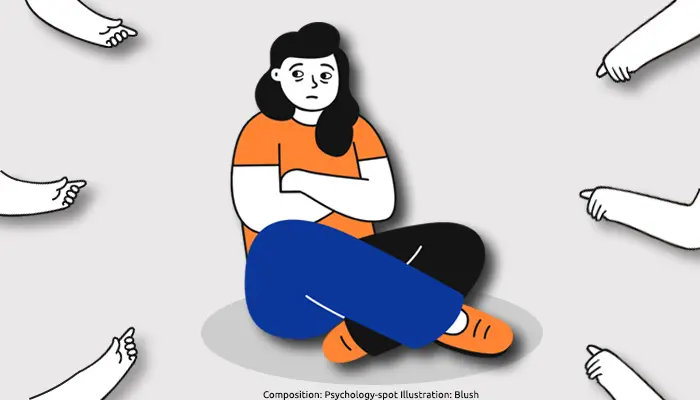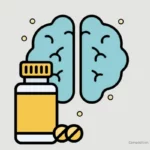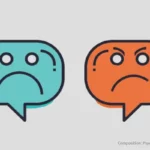
Throughout history and cultures, different religions have performed ritual sacrifices to atone for their sins, evils, and community guilt feelings. On many occasions, an animal was chosen that, despite being completely oblivious and innocent to the problems of the community, was sacrificed for the “common good”.
This custom is known as scapegoat and is a psychological phenomenon that is not limited to society, but also extends to smaller groups such as the family. In dysfunctional families it is not unusual for one of the members to play the role of the scapegoat. He or she becomes the person who bears all the blame and, in a way, carries the weight of the delicate family balance on his or her shoulders.
The role of the scapegoat in the family
The surest strategy to keep a group cohesive, controlled and looking in the same direction is to designate a common enemy. It is a tactic used by rulers but also appreciated in toxic families. In those cases, they choose a member who becomes the repository for the family’s dissatisfactions, frustrations, and guilt.
The scapegoat in the family fulfills two main functions, as revealed by psychologists at the University of Kansas:
• Minimizes the family’s feelings of guilt for their responsibility for a negative result, helping them to maintain a more positive image of themselves and their functioning.
• Preserves a sense of control as the scapegoat provides a clear explanation for a negative outcome that would otherwise seem inexplicable to us unless the family took full responsibility.
In other words, the scapegoat plays a leading role in the narrative that the family builds to exonerate itself by becoming the reservoir of all negative feelings, attitudes and behaviors that the familiy does not want to recognize as its own. The scapegoat becomes a tool to explain family failure or bad actions, while preserving a positive image.
This person, considered as the black sheep, allows the family to think that they are a healthier and more functional unit than they really are. If it weren’t for that individual, the family would be perfect and happy.
The scapegoat theory in toxic families also explains that this person acts as a kind of escape valve to give way to the tensions that are accumulating in the family, so that it does not disintegrate causing major conflicts among all its members that can lead to violent behaviors.
How is the scapegoat chosen in the family?
In families, it is not unusual for a child to be the scapegoat. Some fathers and/or mothers use their child as a scapegoat to vent their frustrations and blame him or her for their mistakes. The chosen member will become the number one enemy of the whole family. He or she will be the person that everyone points to as the generator of family conflicts, even if he or she is thousands of miles away or even if he or she practically no longer maintains any relationship with the family.
Sometimes is chosen the weakest or most sensitive family member. That person is unlikely to respond to attempts at blaming and humiliation, but will be willing to carry the burden they put on his or her shoulders. Often that pattern of abuse is even justified as necessary to “strengthen” that person.
However, the most common is to choose the strongest or most rebellious member since he or she is usually the one who generates the most problems and usually goes against the established toxic family dynamics. He or she may be the most intelligent member of the family or the most independent one who, in one way or another, threatens the authority of the leader. They are also usually people with a more developed sense of justice than that of the rest of the family members.
The family perceives him or her as “different”, so that they begin thinking that he or she does everything wrong, is rebellious and ungrateful. They believe that this member does not appreciate the “love” he or she receives at home, so they take profit of every occasion for criticizing, disapproving and blaming him or her.
The psychological consequences of rejection and guilt
Being chosen from a young age as the family’s scapegoat has lifelong consequences for that person. They are often people who do not trust themselves or the others, who have low self-esteem and who blame themselves for how the others treat them, making them more vulnerable to abuse and manipulation.
They are also people who experience deep resentment since the love and emotional validation that they should have received in the family was denied them. In those cases, they can become people who react with anger in their interpersonal relationships.
However, the most common is that they behave as a kind of “redeemer” because, unconsciously, they believe they are indebted to the others, so that they often carry problems that do not belong to them and may even dedicate themselves to pursuing other people’s goals to the detriment of their own needs and aspirations.
How to stop being the scapegoat of the family?
Unfortunately, the scapegoat is often represented by a child who does not have the capacity to break free from the role assigned to him or her. In any case, the existence of a scapegoat in the family implies that there is a dysfunctional dynamic that must be addressed.
It is not unusual for the family’s “black sheep” to grow old enough to quickly break out of its toxic environment. However, without a therapeutic intervention or without cutting ties completely, it is difficult to stop being the scapegoat of the family.
Still, the process to stop being a scapegoat does not begin in the family environment but within the person. You need to get rid of the feeling of guilt and understand that you do not have to bear the responsibilities of the others. Building self-esteem and focusing on positive traits that your family has never highlighted, will give you the strength to deal with a toxic environment.
It is also worth setting boundaries with the family, letting them know clearly that you will no longer play the role of the scapegoat.
Sources:
Rothschild, Z. et. Al. (2012) A dual-motive model of scapegoating: Displacing blame to reduce guilt or increase control. Journal of Personality and Social Psychology; 102(6): 1148-1163.
Frear, G. (1991) René Girard on Mimesis, Scapegoats, and Ethics. The Annual of the Society of Christian Ethics; 12: 115-133.
Cornwell, G. (1967) Scapegoating: A Study in Family Dynamics. The American Journal of Nursing; 67(9): 1862-1867.



